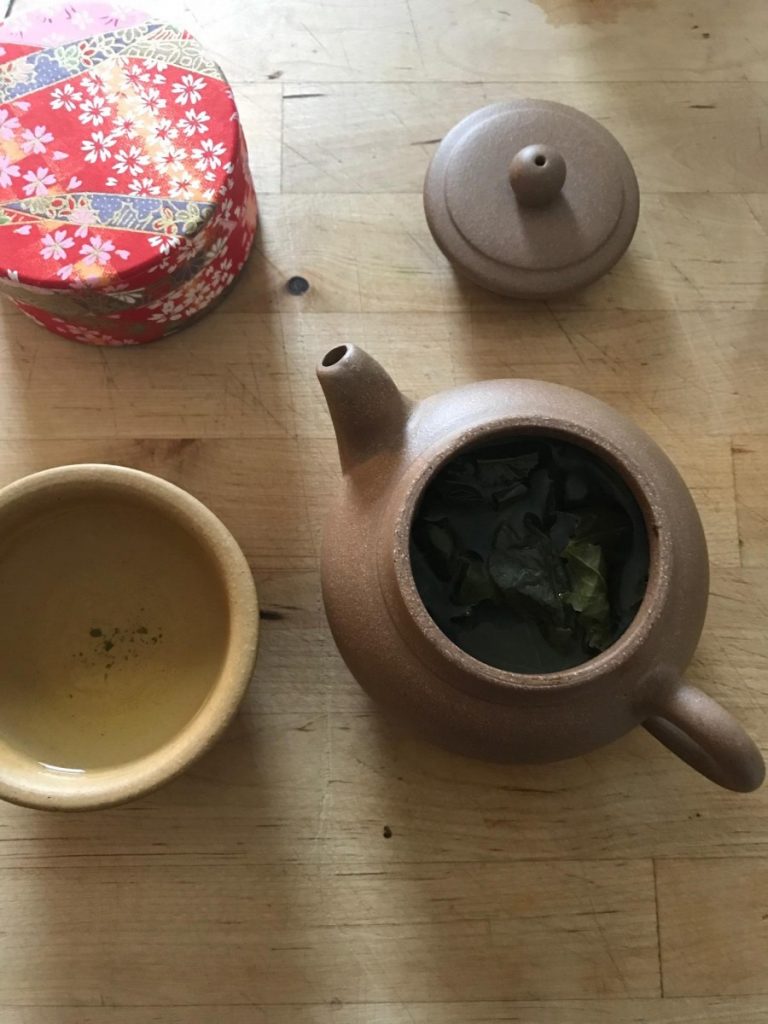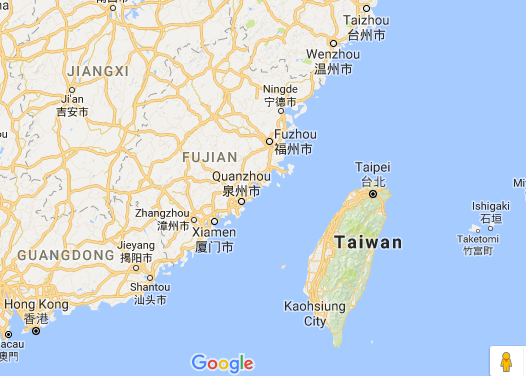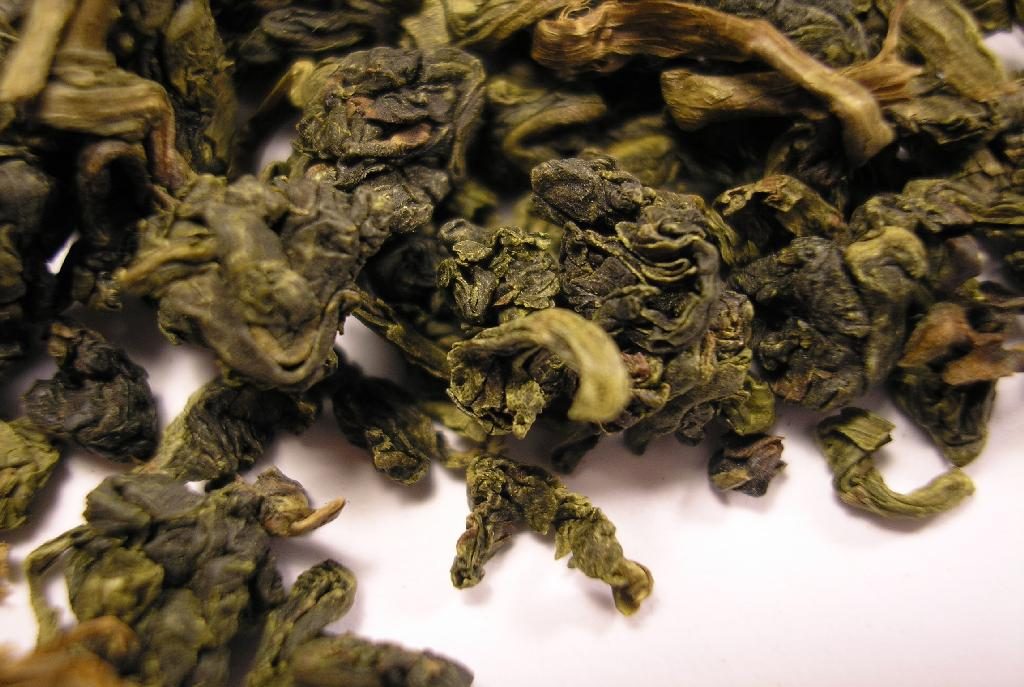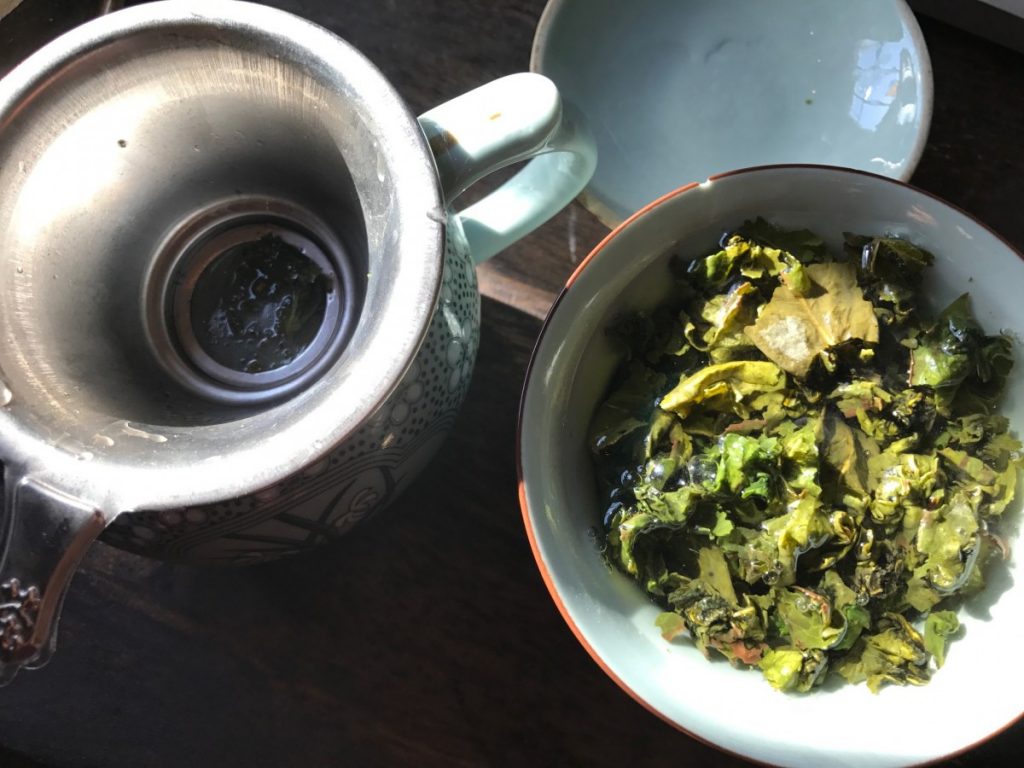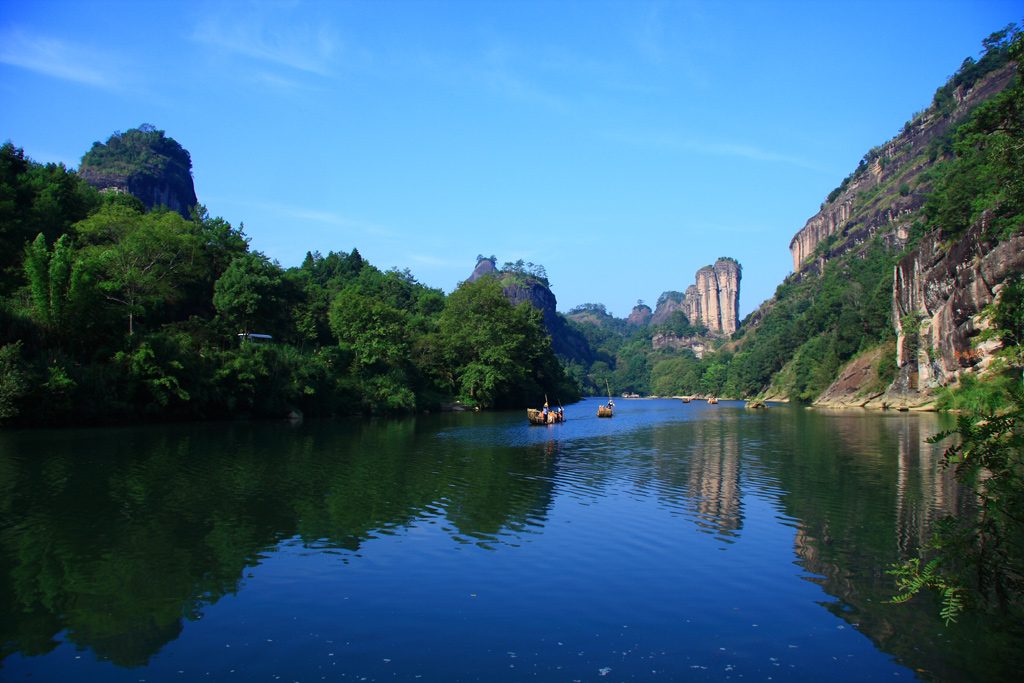(Monkey Pick Oolong)
Week 7 Notes: Preparing for Oolong Workshop
| Daneil Reid | The Art and Alchemy of Chinese Tea |
| Content | Notes | Page number |
| Brief History of Oolong | · Chinese tea was transplanted to Taiwan during the mid-seventeenth Century when Ming Loyalists retreated to the island to escape the onslaught of the Manchu conquest of Mainland China.
· Chinese settlers brought the relatively new hybrid tea known as Oolong from its native home on Wu Yi Mountain in Fujian. · Thrived in the rich volcanic soil and mountain mist of Taiwan’s lush central highlands. · Three types to come out of Taiwan 1. Golden lily 2. Kingfisher Jade 3. Four Seasons Spring · When Japan took colonial possession of Twaiwan in 1895 as a product of the brief Sino-Japanese war, tea production and tea culture in Taiwan continued undisturbed. · When control of Taiwan reverted back to China at the en of WWII, followed a few years later by the Nationalist retreat to Taiwan, the island again became a bastion of traditional Chinese culture · The government invested in infrastructure for tea production and encouraged developments of new plantations with strict quality controls. |
59-60 |
| Oolong Tea
Oolong Characteristics |
· Semi-oxidized tea
· Halfway in character between un-oxidized raw and fully oxidized mature varieties. · Began in the early nineteenth century in coastal Fujian province · Semi-oxidation eliminates the raw grassy taste found in un-oxidized green tea, without producing the strong woody flavor and dark red color of fully oxidized red tea. · Aroma floral and fruity. · High Mountain Oolongs from Taiwan are seen to be high grade. · In China the best Oolong tea comes from the Wu Yi mountain range in Fujian, where Oolong was born. |
80-81 |
| Mountains most famous for Oolong | · Mount Ali (Ali Shan)
· Pear Mountain (Li Shan) · Great Yu Peak (Da Yu Ling) · Pine Grove Stream (San Lin Shi) at the steep wild slopes. |
81 |
| · Semi-oxidation makes it possible to drink copious amounts will less adverse effects. Like an irritated stomach. | ||
| Some well known | · Big Red Robe (so rare 20,000)
· Iron Guan Yin · Taiwan High Mountain Oolong |
|
| High Mountain Oolong and The Chinese Art of Tea
Gong Fu High Mountain Tea Ceremony |
· Lao Ren Cha “Old folks tea”
· The traditional way of preparing and drinking high mountain Oolong · It is called old folks tea since the elderly would have the most time to practice properly · Oolong is known for detoxifying and digestive virtues. https://www.youtube.com/watch?v=t7zUE6xnnCU |
116 |
| · Studies in Japan have shown there are powerful cleansing and protective properties for the lungs
· Volatile aromatics give tea a distinctive fragrance · As gas suspeneded within the fluid of the tea the aromatic elements are excreted from the bloodstream through the lungs rather than the kidneys and as they pass through the delicate lung tissues with each exhalation they dislodge and bind heavy metals. Tars, and other toxins that accumulate in the alveoli (air sacs) and bronchia. · This allows for the residues to be coughed up and spit out · High source of polyphenols and Catechins which are free radical scavengers which neutralize and eliminate the highly reactive metabolic molecules known as free radicals that destroy cells, corrode tissues, and cause premature degeneration of the brain and internal organs. · The antioxidants in high mountain tea provide continuous detoxifying activity in the blood and tissues protecting the body from toxic damage and preventing the formation of tumors. · Lungs and liver particularly · Epigallocatechin gallate is a natural compound in tea that hinders the action of an enzyme that incites cells to divide and could be a promising cure for cancer. · Alkalizes the digestive tract, blood stream, cellular fluids, neutralizing excess acidity which allows formation of cancerous rumors and can lead to other degenerative conditions as well. Blood and tissues acidity is the primary cuase of calcium loss in bones and teeth · Diuretic, helps to promote rapid elimination of toxins and metabolic waste form the blood and tissues · Digestive: breaks down fat molecules into smaller particles making them easier to digest. |
118-121 | |
| · HMO- only contains 0.5 percent caffeine but it contains other compounds that have stimulating effects on the nervous system | 122 | |
| Oolong tea in Taiwan/ four major branches | 1. Classic China Oolong
2. Three hybrids bred in Taiwan (Kingfisher Jade, Four Seasons Spring, Golden Lily) · 1. More mature earthy character and smoky, woody taste · 2. Fresh young flavor, rich, floral, brisk fruity, and tangy. |
126 |
| Little dragon name inspired by a black snake that liked to live in the tea bush | · snakes are sometimes referred to as little dragons | 127 |
| · Ching Shin Oolong “Tender Hearted”: Produced most abundantly in Taiwan. Lightly fermented, hand rolled, and delicately fired. Leaves come from the first pluck
· Da Yeh Oolong “Big Leaf”: Rare variety distinguished by a leaf that is almost the size of a man’s hand when picked. Also known as Buddha Palm; often blended with other varietals by tea masters to create a particular taste. · Tie Guan Yin “Iron Guan Yin”: Named after the beloved Buddhist diety Guan Yin. The Bodhisattva of Compassion. Classic Oolong brought to Taiwan from China. Requires a longer firing process than other varieties of Oolong and only traditional charcoal may be used to heat the oven because the fumes play a central role in developing the unique smoky flavor. Rich mature flaor and deep reddish color. · Dong-Fang Mei-Ren “Oriental Beauty”: Favorite tea of Queen Victoria. Hard to find a good grade or find it at all. · Lao Oolong “aged”: mature Oolong teas are kept stored for years in large clay urns in order to let them age slowly. Produces tea with a robust flavor, dry after taste, and deep red color in the cup. The leaves used for aged oolong must be fully mature when picked then oxidized and well fired to greater degree than other oolongs to insure the tea is sturdy and dry to withstand the aging process. · The three daughters of Taiwan: Oolong varietals were developed by Chinese planters in Taiwan by cross breeding the best strains of the classic Oolong brought from china with tender hearted and big leaf varieties. · Jin Shuan Oolong “Golden lily”: Creamy taste and milky fragrance, golden green color in the cup. · Tsui Yu Oolong “King Fisher”: intense floral fragrance and taste of fresh fruit. · Ssu Ji Chun Oolong “Four Seasons Spring”: hearty hybrid that can be picked six or seven times a year. Each harvest has a fresh flowery flavor of a spring harvest. |
||
| Beautiful Poem | The way of tasting tea
Is found in the form, In the color, In the fragrance And in the flavor.
The beauty in the taste of tea Lies in the person, In the foundation, In the knowledge, In the setting.
· You must first cultivate your taste, foundation, knowledge, and choice of right setting to commune with the nature of the tea you’re drinking. Each week I try to drink the tea I am researching. It helps me to stay awake and balanced, as well as, keeps me grounded in the spirit of what I am studying. |
| Author | Book Title |
| By: Kevin Gascoyne, Francois Marchand, Jasmin Desharnais and Humo Americi | Tea: History, Terroirs, Varieties |
| Content | Notes | Page number |
|
Green Oolong Processing undergo 30% to 50% oxidation
|
First day
· Picking: freshly picked leaves arrive to a factory to start the oxidation process · Withering: leaves are spread out on large sheets. Depending on the weather they will dry for 30 minutes to two hours. If the sun is too strong a canopy will be placed over the leaves to protect them 1. Leaves are spread out on woven bamboo trays about 3 feet in diameter in an environment where the temperature is maintained at 68 to 77 degrees F and the humidity at 60-80%. The leaves are lightly stirred at regular one to four hour intervals 2. The stirring action is important as the friction of the leaves against the bamboo trays breaks down the cellular structure of the leaves and releases oils that contain aromatic substances, further triggering the enzyme polyphenol oxidase. 3. The process is instinctive and depends on the experience of the grower. They will touch and sniff the leaves to know exactly when to stop the oxidation process. · Firing: The leaves are placed in a heated rotating cylinder. They will undergo a heating/stirring. The leaves will then be heated to about 572 degrees F for five to seven minutes. · Rolling: As soon as they’re taken out of the rotating cylinder the leaves are rolled. The mechanical arm attached to a round dome rotates swiftly, causing the leaves to brush the walls of the machine. This helps to release their fragrance. This rolling lasts three to five minutes. · Drying: Drying stabilizes the aromas of the leaves. It also prevents excessive residual moisture from damaging the leaves. Drying starts at 158 degrees F for five or six minutes and then continues for 20-30 minutes at 212 degrees F. · Final: The leaves are spread out on large bamboo trays and left to stand for six to eight hours.
Second day
· On the second day the leaves undergo three basic stages, which are repeated several dozen times. 1. Heating/stirring 2. Rolling 3. Compression · Heating/Stirring: The leaves are placed in a rotating cylinder for a few minutes to soften them. · Rolling: Leaves are formed into a 44 pound package and wrapped in a special fabric. The mass of leaves is placed in a machine equipped with four rotating rollers that compress it into a round shape. · Compression: Still wrapped in fabric the leaves are then placed in another machine where they will be turned and pressurized for 10 minutes while being compressed. *These steps are repeated 10-20 times with a rotating cylinder that is full of air heated to 140-391 degrees F and 30-40 times with a non-heated cylinder. This is what is necessary to create the distinctive bead shape. · Final Drying: The final dry with stabilize the aromatic compounds and allows the producer to remove all the moisture but 2-3%. This phase lasts 5-10 minutes at a temperature ranging from 212-248 degrees F. · Sorting: Leaves are separated from small stems. Sorting is usually done by hand. · Roasting: In Taiwan occasionally the tea will then be fired at a range of 167-320 degrees F to add flavor. The firing plays a role in adding woody, sweet, even caramelized flavor notes. |
138-141 |
| Black Oolong Processing
undergo 70% oxidation
|
· Picking: highly mature leaves. The leaves will be longer and more mature than those those chosen for green tea.
· Withering: leaves are spread out on cloth outside. Depending on the weather they will dry for two hours · Oxidation: When processed manually the leaves are spread on racks and stirred regularly for 12-18 hours in order to break down the cell structure. During mechanical processing the leaves are heated in rotating cylinders in temperatures ranging from 77-86 degrees F, for about eight hours. · Heating: To obtain the twisted appearance a machine roller or person will hand roll it on a bamboo matt. · Drying and firing: The leaves are dried in a rotating cylinder for 10-20 minutes at a temperature ranging from 230-250 degrees F. · Firing: The leaves are placed in a heated rotating cylinder. They will undergo a heating/stirring. The leaves will then be heated to about 572 degrees F for five to seven minutes. The leaves are usually fired twice. (it is possible to wait several months after processing to fire, it doesn’t need to be immediately after the leaves are dried. |
62-63 |
Sources
Gascoyne, Francois Marchand, Jasmin Desharnais, and Hugo Americi. Tea History Terroirs Varieties. A Firefly Book, 2011.
Reid, Daniel. The Art and Alchemy of Chinese Tea. Singing Dragon, 2012.
“Wuyi_Mountains_Sea_of_clouds_4.jpg (1024×683).” Accessed March 7, 2017. https://upload.wikimedia.org/wikipedia/commons/8/82/Wuyi_Mountains_Sea_of_clouds_4.jpg.
“Wu Yi Oolong – Google Search.” Accessed March 7, 2017. https://www.google.com/search?q=golden+lily+oolong&biw=1271&bih=489&source=lnms&tbm=isch&sa=X&ved=0ahUKEwj5s6in9MPSAhXHqVQKHTOPDWYQ_AUIBigB#tbs=sur:f&tbm=isch&q=Wu+Yi+oolong&*&imgrc=JHVF7237MCQ9RM:
